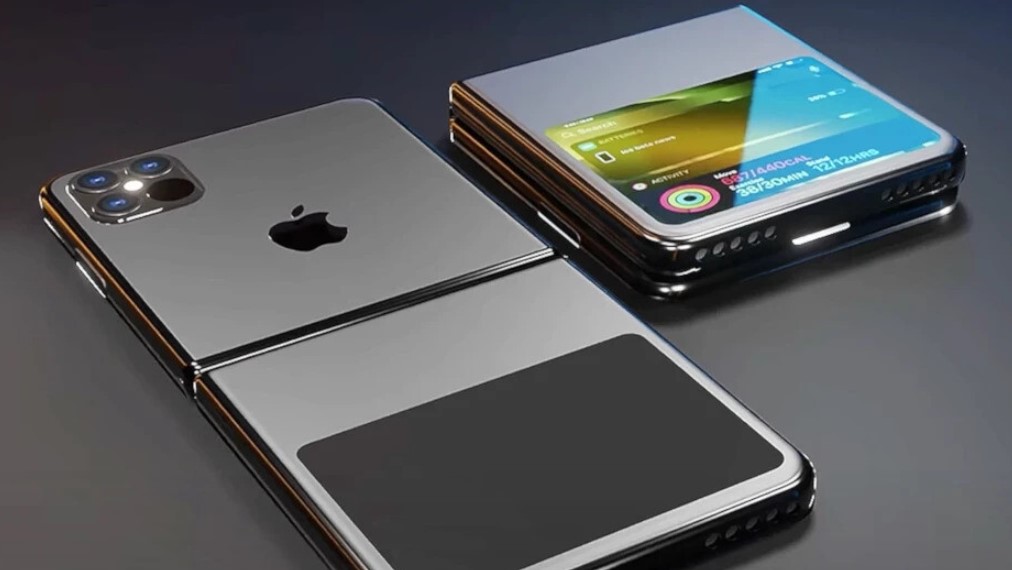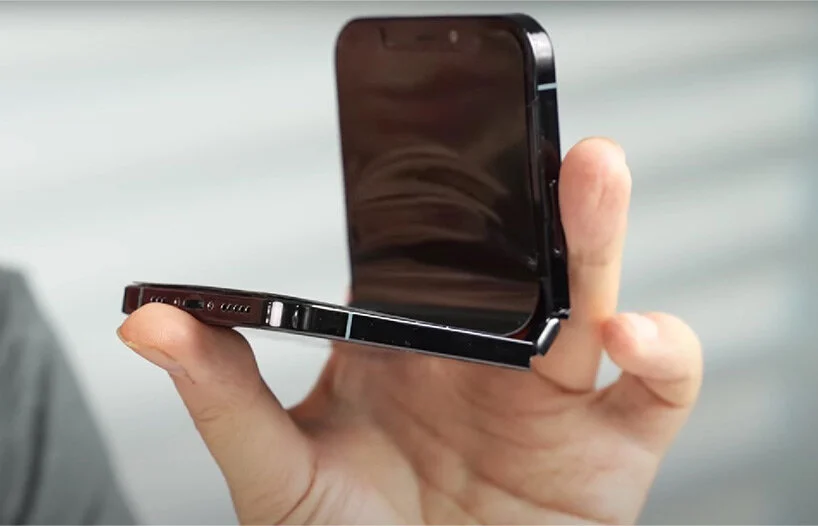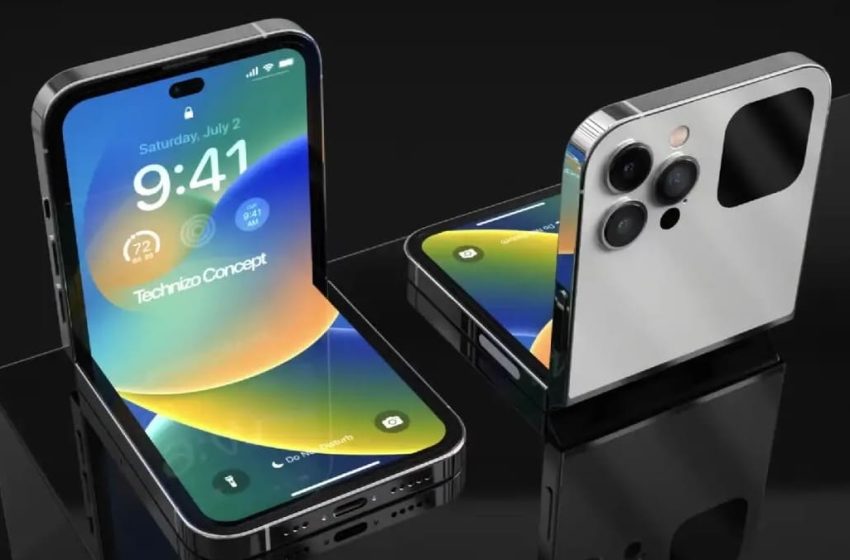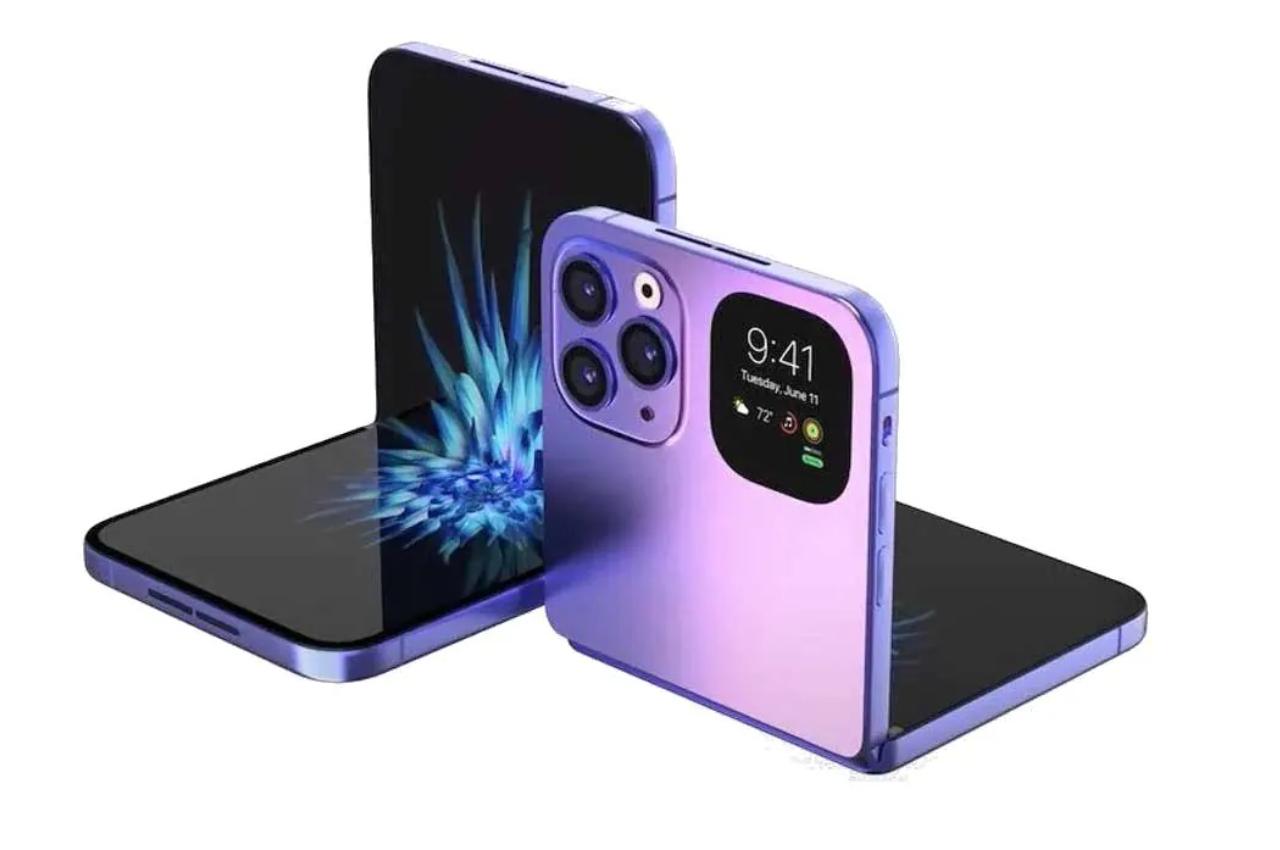Highlights
- Apple has won a new patent in US for a three-layer foldable display.
- The foldable display could be introduced on iPads first.
- Apple has also been awarded a second patent for ‘self healing’ displays.
Apple has been awarded two patents for new display technologies. While the awarding of such patents often do not directly translate into or correspond with a product launch, the reports revealing the patent listings for Apple in the US have sparked off rumours about a long-rumoured smartphone – a foldable iPhone.
How to Make a foldable iPhone ?

Before Apple makes a foldable iPhone, it has to figure out how to make a foldable iPhone.
Research company Omdia claims that in 2021, 11.5 million foldable phones shipped. Apple sells hundreds of millions of iPhones a year.
So if it makes a foldable iPhone, it has to be certain that it can manufacture the phones at the same quality and in a high enough quantity to meet demand. More times than not when Apple introduces a radical hardware change — like 2014’s iPhone 6 Plus and its larger screen – – those models are hard to find at launch because they sell out quickly.
Sometimes they’re given a later release date, as we saw with the iPhone 12 Mini and 12 Pro Max launch. Then there’s the physical complexity that needs to be considered. Foldable phones have numerous mechanical parts that could malfunction or wear, such as hinge components that keep dust out and the various layers behind the folding screen. In fact, when journalists tested review units of the original Galaxy Fold, the device was plagued by hinge and display failures. That was years ago, of course, and Samsung has since fixed those issues. But it shows what can happen with first-gen products.
Apple patents point to foldable iPhone?

Word regarding the patents comes courtesy of Gizmochina, which states that Apple has also secured a second patent for a display technology with a protective layer that can heal itself from minor scratches and regular wear and tear damages.
It’s not entirely clear as to how this technology would work, although this could include a composite chemical material that comprises the topmost layer of the display to heal certain scratches.
The latest Apple patents listed with the United States Patent and Trademark Organisation (USPTO) reveal that the company is looking to engineer a three-layer foldable display, which in turn could be difficult to crack.
The display in question will use a flexible substrate layer, a thin-film transistor layer, and a protective layer.
The goal for the protective layer at the very top would be to protect the flexible substrate, which is the most susceptible layer in a foldable display, from getting cracked during the rigours of regular usage.
To be sure, the concept of self-healing displays have been around for a long time, but have so far not seen any implementation in the real world.
Apple has also not showcased a real-world hint of launching a foldable iPhone, and its long-time market rival, Samsung, has one of the most established foldable smartphone lineups today.
Rumours, however, have regularly tipped a 2023 launch date for a folding iPhone, which presumably is the reason behind the excitement towards this Apple patent filing.
While neither of the two patents really guarantee anything, it will be interesting to see if either translate into consumer products.
Apple would likely develop a unique software feature (think iMessage or Portrait Mode) to help make its foldable phone standout from what everyone else is doing.
iPhone Fold release date speculation

The launch date of the iPhone Flip is open to speculation, but the latest rumors are pointing toward a 2023 or 2024 launch.
Display analyst Ross Young, who has a track record for being accurate with such tips, has suggested Apple could introduce a foldable iPhone in 2023. That said, even Young believes that 2024 is probably the more likely launch year for such a device. However, a report from Ming-Chi Kuo states that a foldable iPhone may not arrive until 2025. Another analyst, Ben Wood, believes we will at least get a foldable iPad before then.
iPhone Fold display

Ming-Chi Kuo has claimed that the first foldable iPhone will have a huge display measuring 8 inches.
That would be larger than the Galaxy Z Fold 4, which offers a 7.6 inch display when it’s opened up. An 8-inch display would also be nearly as large as the 8.3-inch iPad mini.
A different report claims Apple could be working with LG on a 7.5-inch OLED foldable display panel. But that’s not all – another report from Kuo says that Apple is testing a 9-inch display for a foldable.
That would dwarf any foldable phone on the market right now. Kuo has also said that Apple’s thinking about using color e-ink displays for the exterior display on foldables.
This kind of screen wouldn’t be as reactive as an LCD or OLED panel, but it would be great for keeping battery consumption low.
According to Jon Prosser, Apple has tested two different kinds of iPhone Flip: a fold-out hybrid tablet, similar to the Samsung Galaxy Z Fold lineup, and a clamshell flip phone design akin to the Galaxy Z Flip range.
iPhone Fold design
Those sources also claim Apple will be going ahead with the clamshell design, though it is still early in the development process and there’s a chance things could change.
Patent filings also reveal some of the things Apple may be considering for its foldable, including any future devices that might skip the clamshell design in favor of something else.
In 2020, we became aware of an Apple patent describing a “joint operating mode” which would allow a single-screen device to be supplemented by a magnetically-connected secondary display.
In theory, this mode would allow independent devices to join to comprise one shared space, which doesn’t really pertain to the whole singular foldable panel idea. It’s more Microsoft Surface Duo 2 than Samsung Galaxy Fold.
Yet another patent, originally filed in the second quarter of 2018 and subsequently unearthed by PatentlyApple, depicts a device with a flexible display that folds closed yet still leaves a small strip at the bottom exposed for easy access to notifications and contextual information. Think of it like a miniature Touch Bar, similar to what’s available on the MacBook Pro M2 and older MacBook models.
All that feeds the imagination of designers who post concept renderings depicting possible looks for the iPhone Flip/Fold.
Take this 3D mockup posted by a YouTube account called #OS beta news which looks a little bit like a Galaxy Z Flip copycat, down to its slim bezels, centrally-positioned hole-punch camera cutout, minimal exterior display and vertical orientation.
It’s a design we could envision foldable tablet.
All that feeds the imagination of designers who post concept renderings depicting possible looks for the iPhone Flip/Fold. Take this 3D mockup posted by a YouTube account called #OS beta news which looks a little bit like a Galaxy Z Flip copycat, down to its slim bezels, centrally-positioned hole-punch camera cutout, minimal exterior display and vertical orientation.
It’s a design we could envision Apple actually releasing, at least with more fine-tuning beyond the rough idea presented here.
Another iPhone Fold concept design from LetsGoDigital features a smaller notch and external cover display in addition to a folding screen.
ConceptsiPhone has published a video of an iPhone Flip concept that looks a lot like an Apple version of the Galaxy Z Flip.
It features a smaller notch than the iPhone 14 (although no Dynamic Island like the iPhone 14 Pro), a 120Hz display and an in-screen Touch ID sensor.
The concept design also equips the phone with an M1 chip, which sounds a bit far-fetched, but given Apple now uses its M1 silicon in the iPad Pro and iPad Air, perhaps we will eventually see it in a high-end phone too rather than the usual A-series chip.
Designer Antonio De Rosa tweeted out images that show a foldable iPhone that offers some elements of the Galaxy Z Flip such as an external notification screen, while maintaining some distinctive iPhone touches.
Those include flat edges, an iPhone 13 Pro-like camera array and – in a nod to Apple’s rumored future iPhone plans beyond 2022 – no notch or Dynamic Island at all.
Perhaps the best-looking (and most realistic) iPhone Flip design comes from 4RMD, who envisions a flip phone-style design with a 6.8-inch screen when the phone is open. As with the Galaxy Z Flip, there’s an outer exterior display to handle notifications and other alerts.
When Apple’s first foldable iPhone takes shape, Cupertino won’t be able to go it alone.
Over the last three years, we’ve heard competing rumors that Apple has been in talks with both LG and Samsung to supply the flexible displays for whatever device it ultimately winds up launching. In March 2019, it was reported by Korean media (via MacRumors) that Samsung Display sent Apple panel samples for analysis.
But what if Apple didn’t go with a flexible display for its first folding iPhone, and opted instead for a dual-panel approach like the Surface Duo? That’s a possibility posed by Jon Prosser of Front Page Tech, who suggested Cupertino has prototyped such a design.
Prosser says this device retains the iPhone 11’s rounded appearance – remember, the iPhone 12 re-introduced flat edges to Apple’s lineup – but incorporates a hinge, and that the two separate screens come together fairly seamlessly when outstretched.
The computer renders and illustrations of the foldable iPhone aren’t enough, then take a look at this real-life concept from Technology Aesthetics.
The team there has created a real-life “¡Phone V” using parts from iPhones and a Motorola Razr, although it’s got a lot of problems that go to show just how tricky it is to make phones fold.
We saw a patent in October 2020 which suggested the iPhone Flip could come with an upgraded version of the iPhone’s ceramic shield.
It would be specifically designed for a flexible display, and consist of four layers: a cover layer, a hardcoat layer, an inner surface, and a transparent support layer. That support layer could even be made of glass or sapphire for additional strength.
There’s also been speculation that the display could “heal” itself thanks to a “self-healing material” layer that would minimize the appearance of scratched or dents.
There’s no guarantee Apple will launch such a handset, of course, but Prosser’s report reminds us that the firm’s first foldable phone could play out a number of ways. While flexible panels are all the rage these days, dual-screen hardware could ultimately win out if Apple isn’t enamored with the reliability, durability or cost of a device with a single, folding screen.
In February 2020, one Apple patent emerged that would theoretically allow the foldable display to bend in the middle without creating excessive stress on the panel.
Inside the hinge, the screen would bow out in a sense, creating more of a gradual curve than a hard crease.
The hope is that such a design would assist in durability and extend the life of the display. It’s worth noting the Galaxy Z Flip actually incorporates a design not too dissimilar from this.
Apple has since filed a continuation patent that spells out ways of making the iPhone Flip more durable with the help of a crack-resistant display.
How much would you pay for a foldable iPhone?
Foldable phones ain’t cheap. The Galaxy Z Fold 4 starts at $1,800 and the Galaxy Z Flip 4 at $1,000.
And it’s no surprise that prices for Apple products are at the higher end.
So if an iPhone 14 Pro that doesn’t fold in half already costs $1,000, what would be the price for one that does?
For a foldable iPhone to be successful, Apple would need to create a problem-solving design, scale manufacturing without sacrificing quality and develop hardware along with software that make the most of its foldable build. The price would also have to be premium, but not too high.
iPhone Fold/Flip: The competition to Apple Foldable
If the iPhone Flip doesn’t arrive until 2023, Apple will certainly be giving its rivals a head start on the foldable phone front. Samsung is now up to its fourth version of the Galaxy Z Fold and there’s a new Galaxy Z Flip, too.
Samsung reports some success with foldable phone sales, and you can understand why, since the last two Flip models have cost less than $1,000.
There’s a new Motorola Razr too, offering plenty of upgrades to the original, underwhelming foldable. But it’s only on sale in China, meaning it, like other China-exclusive foldables including the Oppo Find N and the Honor Magic V, aren’t real competitors, as good as they are.
Google had reportedly been working on a Pixel Fold that was rumored to arrive well ahead of anything Apple had in the works. While one report claimed Google walked away from the Pixel Fold, subsequent reports say the project is still on.
A 2022 launch date was out of the question, but some rumors say we could see the Pixel Fold in the first three months of 2023.
As should be clear by now, we still have to see whether anyone outside of Samsung can succeed with foldable phones. But that shouldn’t dissuade Apple, which has rarely been first-to-market with its landmark products. Typically, Apple only launches devices like the iPod, iPhone and iPad when it feels that its addressed the shortcomings of similar devices.
You could see the company take a similar tack with the iPhone Flip.
Concluding Apple Foldable iPhone
Whatever strategy Apple takes in developing its first foldable phone will likely dictate the trajectory of the industry.
Samsung may have been the first out of the foldable phone gate with the Galaxy Fold, but that company is continuing to test out different form factors as it looks to find out what phone shoppers really want.
Apple has a history of instituting major change in the mobile market with every release: the abandonment of the headphone jack, elimination of bezels and adoption of the notch were all trends kicked off by iPhones.
And although 5G handsets are more common than ever, 2020’s iPhone 12 likely served as most people’s introduction to 5G.
Ultimately, foldable tech and the smartphone industry at large has a lot riding on how Apple approaches the dream of an iPhone that folds.
Faqs On Apple Foldable IPhone
1)Is Apple actually coming with a Foldable IPhone ?
Ans1)Analyst Ming-Chi Kuo said, as reported by MacRumors, that “Apple will likely launch a foldable iPhone with an 8-inch QHD Plus flexible OLED display in 2023.” He revised his prediction, in a tweet this past April, to say that it might be 2025 before there’s a foldable screen device from Apple.
2)How much would you pay for a foldable iPhone?
Ans)Foldable phones ain’t cheap. The Galaxy Z Fold 4 starts at $1,800 and the Galaxy Z Flip 4 at $1,000.
And it’s no surprise that prices for Apple products are at the higher end.
So if an iPhone 14 Pro that doesn’t fold in half already costs $1,000, what would be the price for one that does?
For a foldable iPhone to be successful, Apple would need to create a problem-solving design, scale manufacturing without sacrificing quality and develop hardware along with software that make the most of its foldable build.
The price would also have to be premium, but not too high.
3)How will the Apple Foldable Camera be ?
Ans)Foldable iPhone camera While the folding iPhone is at a very early stage and there’s no information about the cameras Apple is planning for it, we can reasonably expect it to have ultra-wide and telephoto cameras, alongside a main one. And of course, a front-facing selfie camera, possibly inside a notch or using under-display technology, which should have matured enough by 2022.
4)How will the Foldable iPhone software be ?
Ans)If Apple designs a foldable iPhone akin to the Galaxy Z Flip or Moto Razr (2020), then its iOS software won’t need to be too different from that on the average iPhone. The only notable addition would be a new notification screen for the phone’s potential secondary display.
However, if the foldable iPhone is like the Galaxy Z Fold 2 or Surface Duo, meaning that it will unfold into a tablet, there’s the potential for iOS to switch to iPadOS on the fly when the user unfolds the iPhone. Not that iPadOS is notably different from iOS, but its interface is better optimized for larger displays, and it offers split-screen multitasking.

